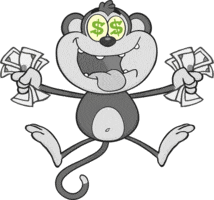Counting Coins and Bills Worksheets
The world is slowly, but surely moving to more digital world currency. Isn’t good ole’ cash a thing of beauty? This is something I love to share with my students because they are super energized when it comes to money. That is because they are taught at a very early age that this stuff can be used to get them some cool stuff. In most cases, tools or something leisure based. There four heavily traded coins (penny, nickel, dime, quarter) in American currency. There is also one rarely traded coin that is called the half-dollar. These bills and coins have been traded for well over two centuries. This worksheet series helps students quickly learn how to sum up United States dollars and coins.
Aligned Standard: 2.MD.C.8
- Layout the Money Step-by-Step Lesson- We give a value to every coin and bill; penny through a ten spot. You then have to find the total value.
- Guided Lesson - Not only do you have to find the total value of the coins and bills, but you need to make your own coins and bills.
- Guided Lesson Explanation - I ran with the one to one explanation for these; I found it easier to understand.
- Practice Worksheet - Most of the practice is in word problem format.
- Matching Worksheet - Match the dollars and coins described to values of the word problems.
- Counting Dollars and Change Lesson - This is a bit simple, but a great way to review for students that are a bit behind the rest of the class.
- Dollars and Change Counting - A straight up counting series of exercises.
- Answer Keys - These are for all the unlocked materials above.
Homework Sheets
Start by counting your change and then we ask you to draw it.
- Homework 1 - Here 1 bill value is 10 dollars. We know that 1 quarter is equals to 25¢.
- Homework 2 - Here 2 bills have a value of 10 dollars, 2 bills value is 5 dollars.
- Homework 3 - Will gave a loan of $ 45.76 to Sherry. Label the bills and coins below that would give you this value.
Practice Worksheets
Students should have a good handle on counting currency after these sheets.
- Practice 1 - Rocky goes to the cafe and pays $20.25. Label the bills and coins below that would give you this value.
- Practice 2 - Frank buys grocery for $15.50. He has 2 bills and 2 coins. Draw the money using rectangles for bills and circles for coins. Label the value of each bill and coin.
- Practice 3 - Sam spends $20.51 on toys. Label the bills and coins below that would give you this value.
Math Skill Quizzes
We try to get all the quizzes into these sets.
- Quiz 1 - Julie buys jeans for $10. She pays with just 2 bills. Draw the money using rectangles for bills. Label the value of each bill and coin.
- Quiz 2 - Jacky gets a football for $10. He has 1 bill. Draw the money using rectangles for bills. Label the value of each bill.
- Quiz 3 - Sarah buys a mobile game for $50. She has 5 bills. Draw the money using rectangles for bills. Label the value of each bill.
Tips for Counting Coins and Bills

Almost every kid loves to collect coins and heap them up in a piggy bank. But most kids find it difficult to count their collected treasure. Here we have discussed a few tips that will help you in counting your collection of coins. Empty your piggy bank and gather all your collected coins. Separate the collected coins depending on their type.
Sort Everything - Create separate piles of each type of coin. Coins worth a particular amount should be separated and grouped together. You should even put those in order from lowest to highest value (pennies, nickels, dimes, quarters).
Pile Them in Groups - Once you have separated them in different piles, count each of the pile separately. Start working with one pile at a time, place one pile of coins in front of you and put other piles aside. For example, if you are working with dimes, place that specific pile in front of you and place others aside. Count one coin at a time. Stack the coins in a pile of 10 coins. Stack of 10 coins works ideally and separate the rest. Place the remaining coins in other stacks. Once you have piled the coins in a stack of 10, multiply the number of piles with 10. Take the stacks of that particular coin and multiply it with 10. You will get to know how many coins you have of that particular type.
Count Coin Stacks - I would suggest you keep track the number of stacks of coins you have using a tally chart. Also note how many left over coins, those that did not fit into 10 stacks, you have.
Do the Math - Take the number 10 stacks you have and multiply it by the value of a 10 stack. Penny stacks equal 10 cents. Nickel stacks equal 50 cents. Dime stacks equal 100 cents (1 dollar). Quarter stacks equal 250 cents (2 dollars and 50 cents). Also count your left-over coins, those that you did not have enough of to create a 10 stack, all together. Add all 5 of those values together to get a coin total.
Counting Bills - Bills are much simpler to count because they just represent whole values of dollars. Just add that whole number value of dollars to your calculation for the coins and you have your total.